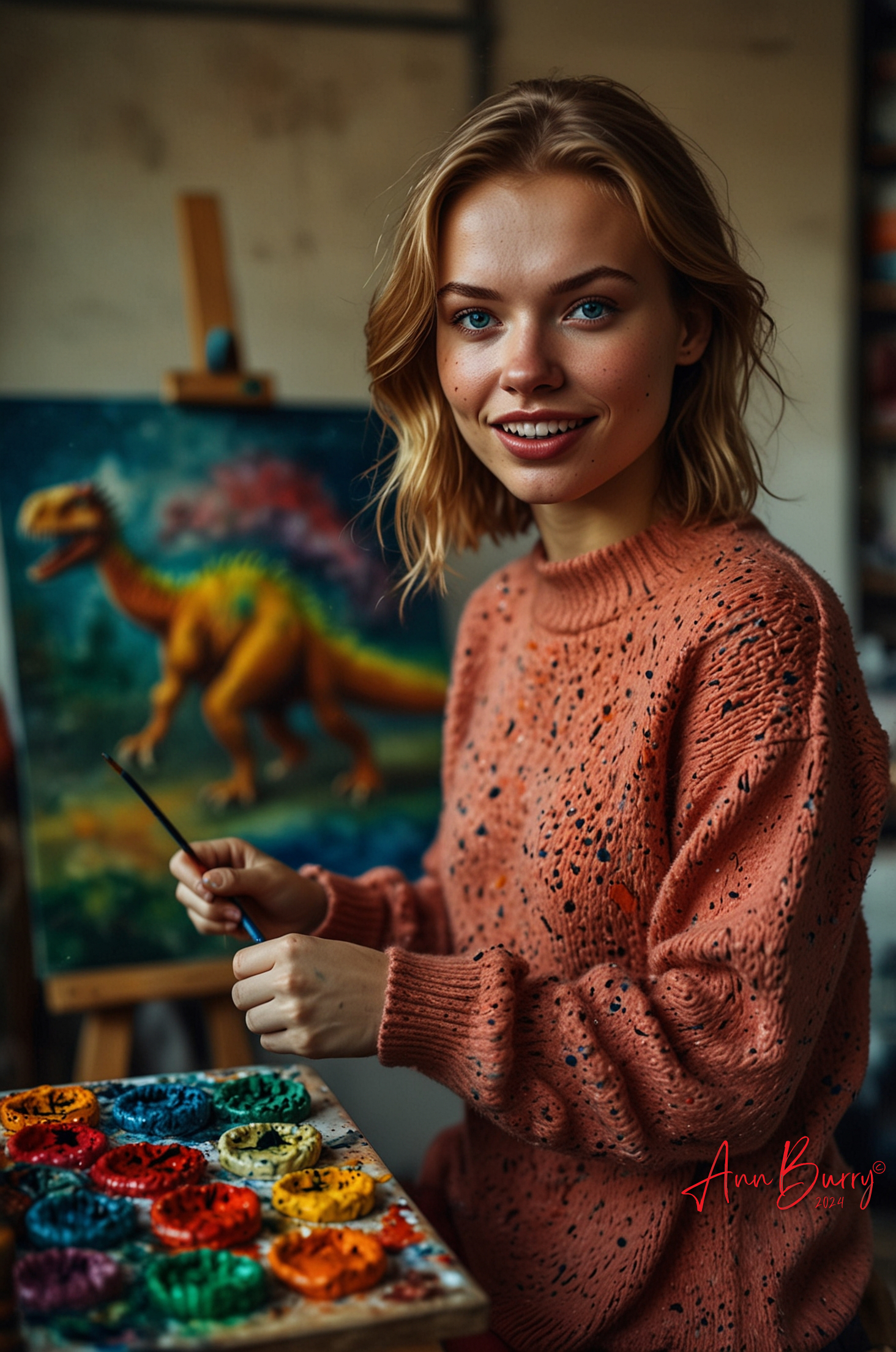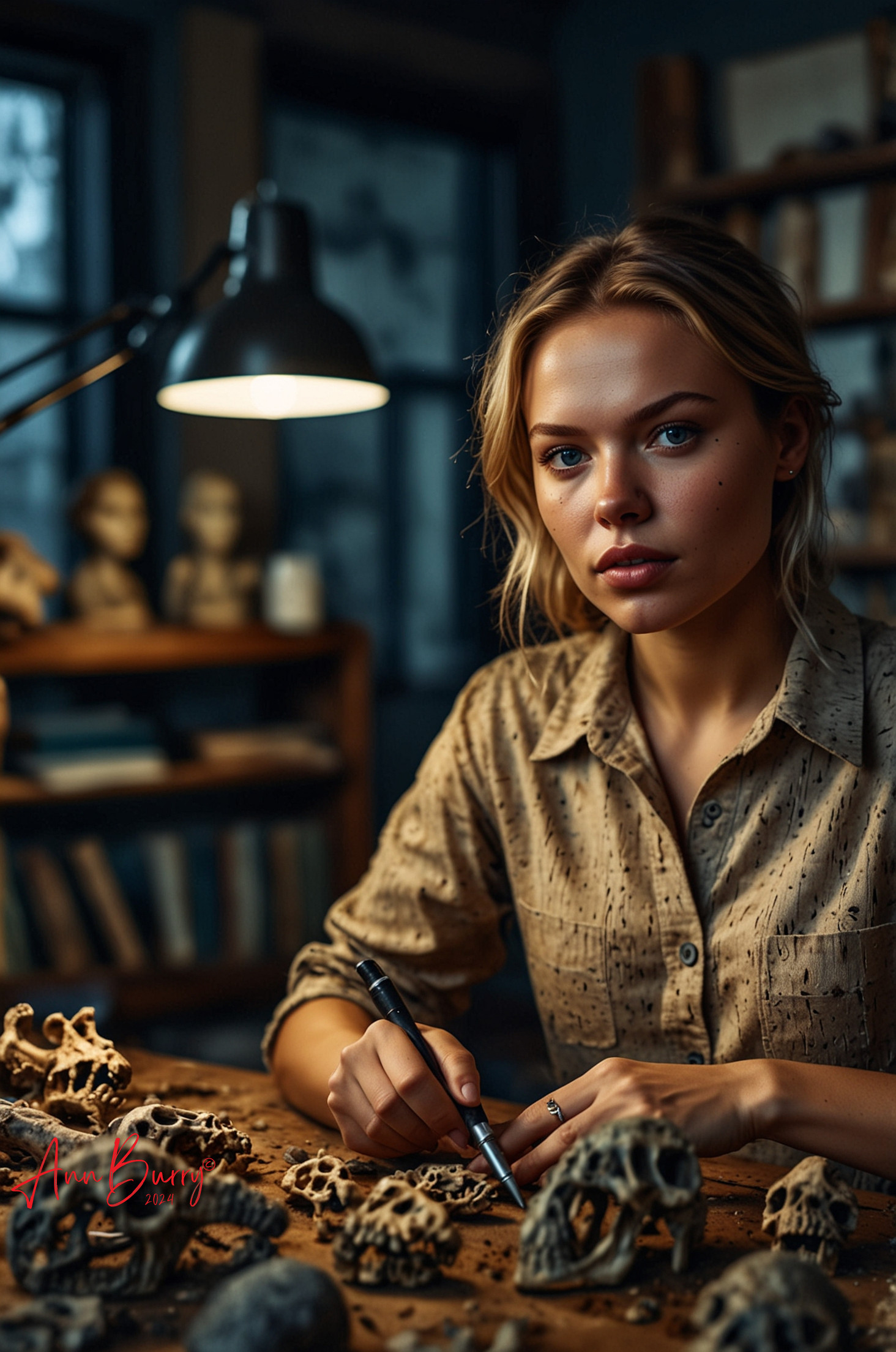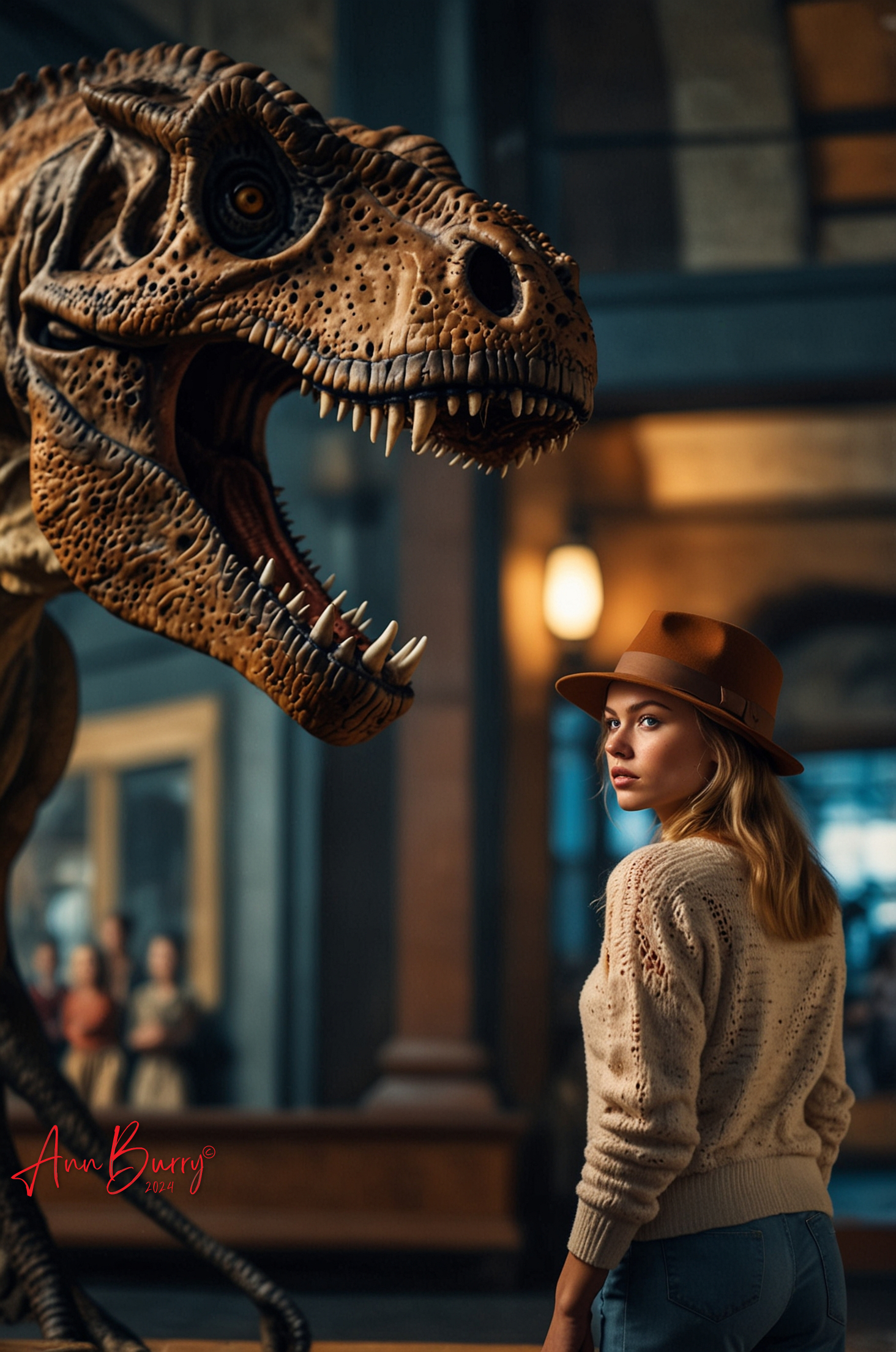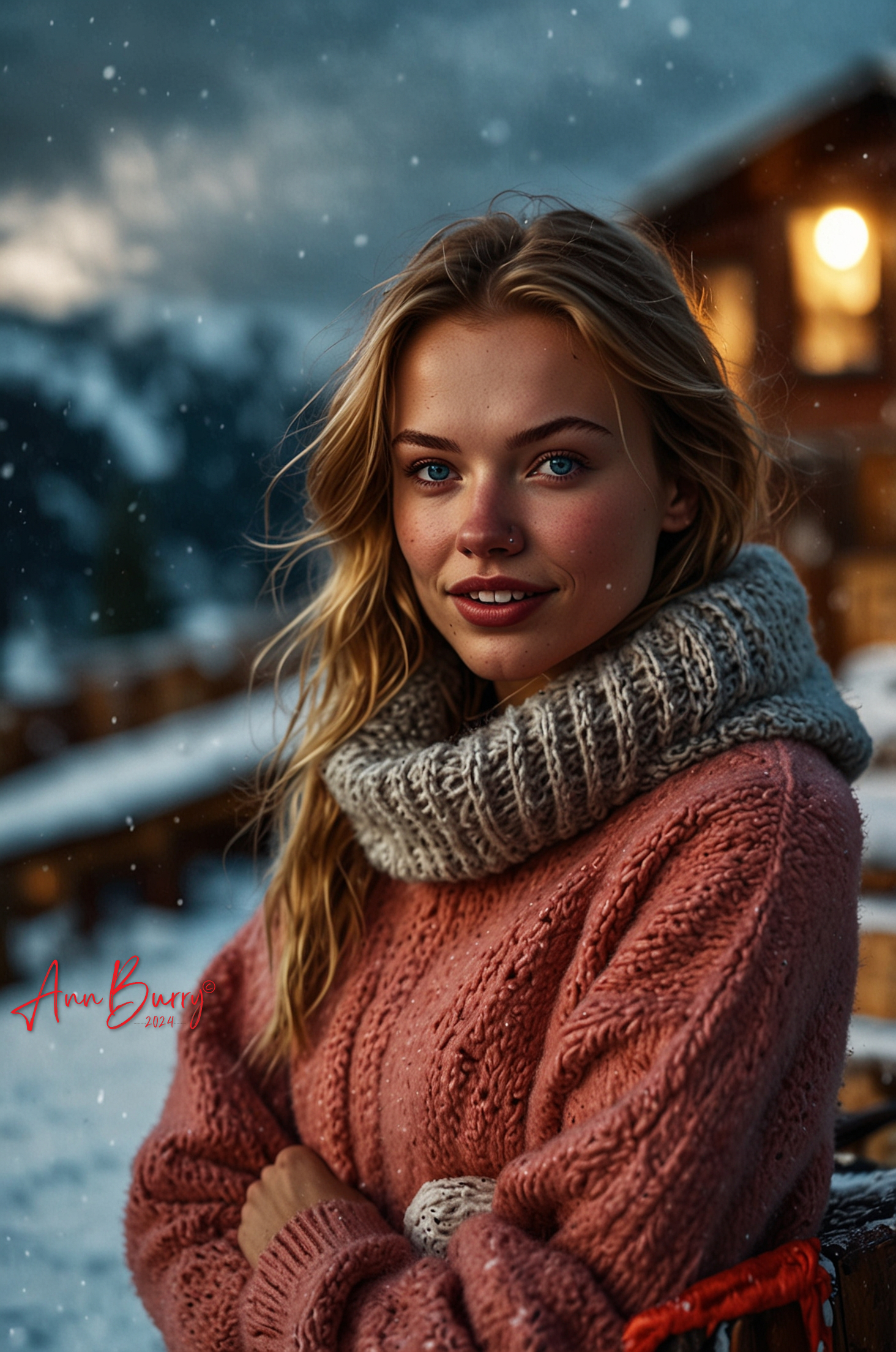I am painting
My name is Ann Burry, and I hail from Falls Creek, a quaint town nestled in the heart of Australia. Ever since I can remember, I’ve been captivated by two things: the breathtaking beauty of the natural world and the awe-inspiring mystery of dinosaurs. As a child, I would spend hours exploring the lush forests and rugged landscapes around Falls Creek, my imagination soaring with visions of ancient creatures that once roamed this land.
It was no surprise to anyone that I became a painter, nor was it surprising that my subject of choice was dinosaurs. Every stroke of my brush brings these magnificent beasts to life, capturing their grandeur and might, their grace and ferocity. My studio, a small converted barn on the outskirts of town, is a sanctuary where the past and present collide.
This morning, I woke up before dawn, the air crisp and fresh with the promise of a new day. After a quick breakfast, I headed to my studio, eager to continue my latest project. I’ve been working on a series of paintings that depict a family of Argentinosaurus, one of the largest land animals to ever exist. The sheer size of these creatures is both daunting and exhilarating to portray on canvas.
As I mix my paints, I think about the fossils I’ve studied and the scientific papers I’ve read. Each painting I create is a blend of artistic expression and scientific accuracy. I want my audience to feel the weight and presence of these dinosaurs, to understand their place in the world that existed millions of years ago.
Hours pass in a blur as I lose myself in my work. The sun climbs higher, casting a warm glow through the windows. I pause to take a break, stepping outside to stretch and breathe in the fresh air. The tranquility of Falls Creek is the perfect counterbalance to the intense focus of my painting sessions. It grounds me, reminds me of the connection between all living things, past and present.
In the afternoon, I receive a call from the local museum. They’re hosting an exhibition next month, and they want to feature my work. Excitement bubbles up inside me. This is a fantastic opportunity to share my passion with a wider audience, to educate and inspire others about the fascinating world of dinosaurs.
With renewed energy, I return to my studio and continue painting. As the sun sets, casting long shadows across the room, I step back to admire my progress. The Argentinosaurus family is coming to life, each brushstroke adding depth and dimension to their massive forms. I can almost hear their calls, feel the ground shake beneath their feet.
Painting dinosaurs isn’t just about recreating their images; it’s about bringing a piece of history back to life, about bridging the gap between the ancient and the modern. It’s my way of preserving their legacy, of ensuring that these incredible creatures are never forgotten.
As I clean my brushes and prepare to close up for the night, I feel a deep sense of satisfaction. This is more than just my job; it’s my passion, my calling. And as long as there are stories to tell and dinosaurs to paint, I’ll be here in my studio, bringing the past to life, one canvas at a time.


I am study
My journey to learning about dinosaurs has been a multifaceted adventure, encompassing formal education, hands-on experiences, and a deep personal passion. Here’s how I’ve delved into the world of these magnificent creatures:
Formal Education
My formal education laid the foundation for my understanding of dinosaurs. I pursued a degree in Fine Arts, but I took elective courses in paleontology and biology to complement my artistic studies. These courses introduced me to the basics of dinosaur anatomy, evolutionary biology, and the geological periods in which they lived.
Self-Study and Research
Beyond the classroom, I dedicated countless hours to self-study. I devoured books, scientific journals, and documentaries about dinosaurs. Some of my favorite resources include:
Books by renowned paleontologists like "The Rise and Fall of the Dinosaurs" by Steve Brusatte and "Dinosaurs: The Most Complete, Up-to-Date Encyclopedia for Dinosaur Lovers of All Ages" by Thomas R. Holtz Jr.
Scientific journals such as the Journal of Vertebrate Paleontology and Paleobiology, where I found detailed research papers on the latest discoveries and theories.
Documentaries and educational series like BBC’s "Walking with Dinosaurs" and National Geographic specials, which provided visual and narrative context to the scientific data.
Museum Visits
As mentioned earlier, visiting museums has been a cornerstone of my education. Walking among the skeletons and fossils, observing the reconstructions, and reading the detailed exhibits provided a tangible connection to the ancient past. Interacting with museum staff and participating in guided tours deepened my understanding and sparked my curiosity.
Paleontological Sites and Fossil Digs
Whenever possible, I’ve participated in paleontological digs and visited fossil sites. These hands-on experiences are invaluable. For example, joining a dig in Queensland’s Winton Formation allowed me to work alongside paleontologists, uncovering dinosaur bones and learning about excavation techniques. These experiences have given me a profound appreciation for the meticulous work involved in paleontology.
Online Courses and Lectures
With the advent of online learning platforms, I’ve been able to take courses from top universities and institutions around the world. Platforms like Coursera, edX, and Khan Academy offer courses on paleontology, geology, and evolutionary biology. I’ve taken classes taught by experts like Dr. Philip Currie and Dr. Paul Sereno, which provided a structured and comprehensive education on the subject.
Networking with Experts
Building connections with paleontologists, museum curators, and fellow dinosaur enthusiasts has been crucial. Attending conferences, participating in online forums, and being active in social media groups dedicated to paleontology have allowed me to stay updated on the latest discoveries and research. Networking has also provided opportunities to ask questions and gain insights directly from experts in the field.
Artistic Practice and Reconstruction
My artistic practice itself is a form of learning. When I paint dinosaurs, I strive for anatomical accuracy, which requires extensive research. I study skeletal structures, muscle formations, and skin textures, often consulting with paleontologists to ensure my reconstructions are as accurate as possible. This process of translating scientific data into visual art deepens my understanding and keeps me engaged with the latest scientific findings.
Continuous Curiosity and Passion
Ultimately, my learning journey is driven by an unending curiosity and passion for dinosaurs. This fascination keeps me motivated to explore, ask questions, and seek out new knowledge. Whether it’s a new discovery published in a journal or a conversation with a fellow enthusiast, I’m always eager to learn more about these incredible creatures that once ruled the Earth.
Through this multifaceted approach, I’ve built a comprehensive understanding of dinosaurs, which enriches both my personal knowledge and my artistic work.
I am in Museum
Visiting museums has always been an integral part of my journey as a painter of dinosaurs. These excursions are not just about observing; they are about immersing myself in the world of these ancient creatures, learning as much as I can to ensure that my artwork is both scientifically accurate and artistically compelling.
I remember my first visit to the Australian Museum in Sydney vividly. I was a teenager, and the experience was nothing short of magical. Walking through the exhibit halls, I was surrounded by towering skeletons, meticulously reconstructed dioramas, and interactive displays that brought the prehistoric world to life. The sight of a fully assembled Tyrannosaurus rex skeleton left me in awe, its sheer size and formidable presence sparking my imagination.
Since then, museum visits have become a regular part of my routine. Whenever I start a new project, I plan a trip to a museum or a paleontological site. These visits are meticulously planned and involve extensive note-taking, sketching, and photographing. I study the fossils, paying close attention to the details of bones, teeth, and claws. I read every plaque, listen to every audio guide, and engage with the interactive displays to understand the science behind the reconstructions.
One of my favorite places to visit is the Melbourne Museum, home to an impressive collection of dinosaur fossils and one of the most comprehensive paleontology exhibits in the country. The museum’s galleries are filled with fossilized skeletons, life-sized models, and detailed information about the creatures that once roamed our planet.
During my visits, I often arrange to meet with the paleontologists and curators who work there. Their insights are invaluable, providing me with detailed information about the latest discoveries and theories in the field of dinosaur science. These experts help me understand the nuances of dinosaur anatomy, behavior, and ecology, which I incorporate into my paintings. Conversations with them have deepened my appreciation for the complexity and diversity of these ancient animals.
I also visit smaller, lesser-known museums and local fossil sites. Falls Creek itself has a small museum dedicated to regional natural history, including a few dinosaur fossils found in the area. Though the collection is modest, it is a treasure trove of local paleontological discoveries, and the curators are always eager to share their knowledge and enthusiasm.
My travels have taken me beyond Australia, too. A trip to the American Museum of Natural History in New York was particularly memorable. The museum’s dinosaur halls are world-renowned, and seeing the vast array of specimens from North America gave me a broader perspective on dinosaur diversity and evolution. Standing beneath the colossal Barosaurus in the museum’s main hall, I felt a profound connection to the ancient past, and a renewed commitment to my art.
These museum visits are more than just educational excursions; they are a source of inspiration. Being in the presence of actual dinosaur fossils, seeing the scale and intricacy of their remains, fuels my creativity and informs my work. Every detail I learn, every fossil I study, becomes a part of my artistic process.
When I return to my studio in Falls Creek, I bring back more than just sketches and notes. I bring back a deeper understanding of the dinosaurs I paint, a connection to the scientists who study them, and a renewed passion for my craft. Each painting becomes a fusion of art and science, a testament to the incredible creatures that once walked the Earth and the ongoing quest to understand their lives.


I am freezing .....
Falls Creek, nestled in the Australian Alps, is known for its cold climate, especially during the winter months. The village transforms into a winter wonderland, with temperatures often dropping well below freezing, making it one of the premier destinations for skiing and snowboarding in Australia.
During the winter, temperatures in Falls Creek can range from -5°C to 5°C (23°F to 41°F), with heavy snowfall blanketing the area. Even in the summer, the weather can be cool, with temperatures typically ranging from 5°C to 20°C (41°F to 68°F). The alpine environment means that the weather can be quite variable and often windy, adding to the chill factor.
As a painter, my studio is an old converted barn on the outskirts of Falls Creek. Despite being insulated and equipped with a heater, the cold can still seep in, especially during the early mornings and late evenings when I'm most often at work. The cold can make it difficult to concentrate and work effectively, which is why I rely on warm clothing to stay comfortable.
Wool sweaters are a staple in my wardrobe, providing the perfect balance of warmth and breathability. Wool is an excellent insulator, trapping heat close to the body while allowing moisture to escape, which helps to regulate my body temperature. This natural fiber is also incredibly durable and soft, making it ideal for long hours spent in the studio.
I have a collection of wool sweaters, each with its own story. Some were handmade by local artisans, showcasing traditional patterns and techniques passed down through generations. Others were gifts from friends and family, each one a reminder of their support and love. The rich textures and vibrant colors of these sweaters often inspire my work, reminding me of the connection between nature, art, and community.
On particularly cold days, I layer my wool sweaters with other warm clothing, such as thermal shirts and thick socks. This layering not only keeps me warm but also allows me to adjust my clothing as the temperature changes throughout the day. Sometimes, I'll wrap a wool scarf around my neck and pull on a cozy beanie, adding an extra layer of warmth and comfort.
Wearing wool sweaters has become a comforting routine, a way to prepare myself for the creative process. As I pull on a sweater and feel its warmth envelop me, I know I'm ready to face the day, regardless of how cold it might be outside. This ritual grounds me, connecting me to the rhythms of life in Falls Creek and the timeless art of painting dinosaurs.
In many ways, my wool sweaters are a symbol of my life here—a blend of practicality and artistry, warmth and resilience, tradition and creativity. They are as much a part of my identity as my paintings, each stitch and thread a testament to the life I've built in this beautiful, chilly corner of the world.
